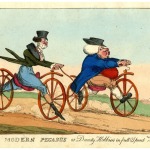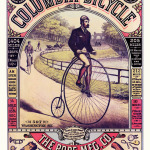
The bicycle is so much more than two tires, brakes & handlebars.
Dr. Paul Smethurst, an English professor at the University of Hong Kong, profiles the bicycle and the cultural significance embedded within.
Dr. Paul Smethurst is associate professor in the School of English at the University of Hong Kong, where he teaches travel writing, geocriticism and the contemporary novel. His publications include The Postmodern Chronotope (2000), Travel Writing and the Natural World (2013) and The Bicycle in History (forthcoming 2014). He is currently editing a new collection of essays on travel writing (New Directions in Travel Writing Studies, forthcoming 2015). In a previous career he developed digital mapping and geographical information systems. His book, ‘The Bicycle: Towards a Global History’, will be published by Palgrave Macmillan in Spring 2015
A Cultural History of the Bicycle
![]()
When the iconic ‘high’ bicycle appeared in the 1870s with the rider perched on top of an over-sized front wheel, it had limited appeal. But a cycle craze had begun and inventors worked hard to improve on the design. Within a decade the bicycle as we know it today had arrived.
In the 1890s, cycling was already a popular sport and a recreational fashion for the well-to-do. Half the bicycles produced in England in the 1890s were for women, reflecting a major social upheaval. Women’s rights and the idea of emancipation were linked to the rise of the bicycle in the West. While in China, it was tied to the cultural revolution and the suppression of individualism. But then, in the 1980s, the bicycle helped organize resistance to the State in the Tiananmen Square protests.
With contradictory strands like these, the bicycle’s cultural history is a rich subject for academic study, and this also has an aesthetic dimension. For example, the bicycle in western art might express an existentialist struggle to overcome the inertia of matter, but in Africa and Asia it is more likely to symbolize the intrusion of western modernity.
Many histories of the bicycle already exist, but there are as yet no comparative studies of its cultural history. My research reveals wide variation in the bicycle’s cultural significance around the world, but there is a common thread: I argue that a universal desire for mobility is at the heart of modernity wherever and whenever it strikes. The desire to travel at speed under your own power – whether for pleasure or necessity – is a constant. This is as true in the postmodern ‘back to the future’ atmosphere of the 21st century as it was amid the futurism of the 1890s.
Read More: Cycling Through Space & Time





